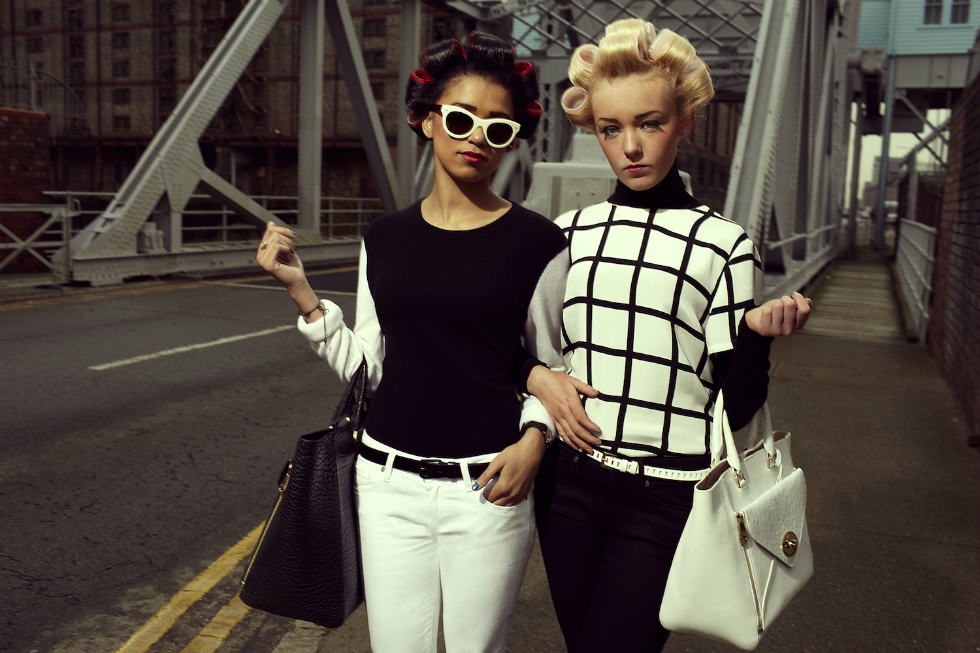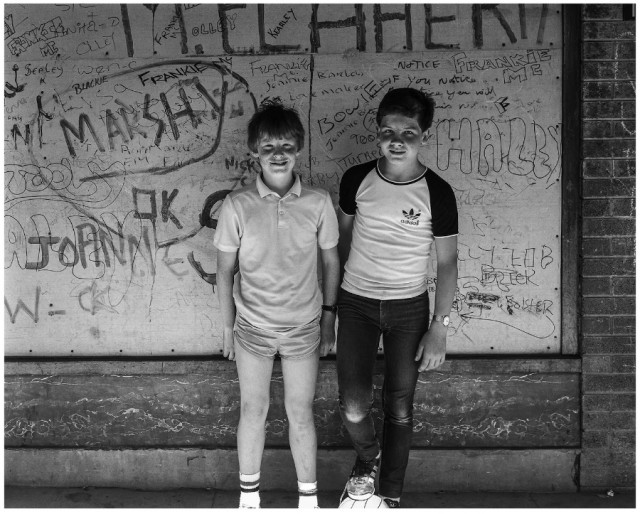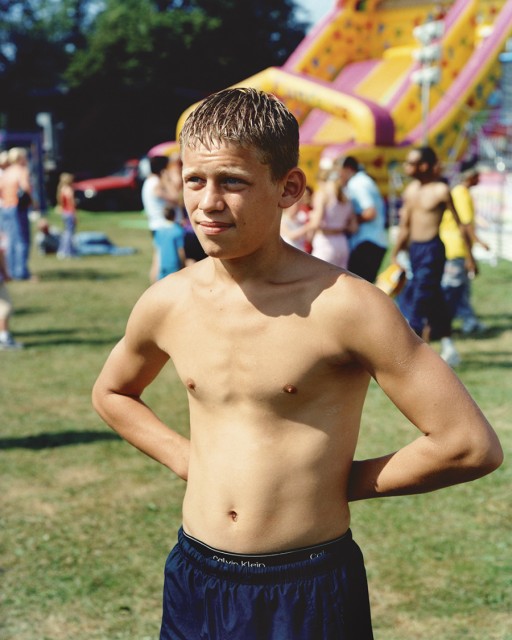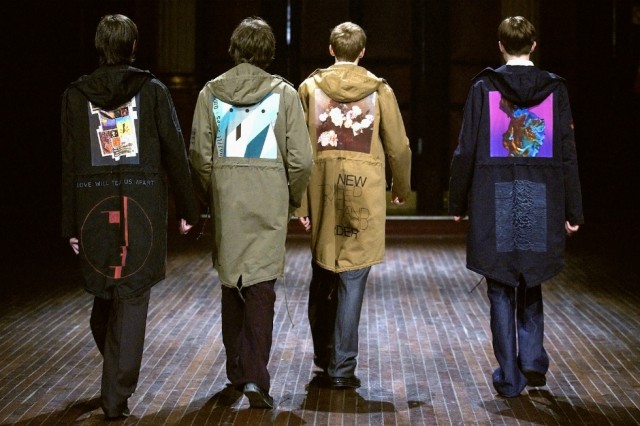“There is a thirst for something new, something authentic” — North: Identity, Photography, Fashion

Reshaping how the North of England is viewed? Jacob Charles Wilson interviews the curators of Open Eye Gallery’s new exhibition — highlighting Northern contributions to modern culture…
There’s a narrative of Northern English culture that likes to be told and retold; the people are warm and chipper; it’s grim and cold. An unstable and contradictory definition of “Northernness” that parallels how the North itself is seen by the rest of the country; insular and disconnected, amorphous and confrontational, something else. Over the past few years these stereotypes have led the North to be blamed for all sorts of political disasters and to face cultural neglect, such as Bradford’s loss of The Royal Photography Society’s collection, the disparaging that Hull received when it was named as the City of Culture 2017, and the decade it took to list Preston’s brutalist bus station.
But, depending on who or where you ask, what we call The North hasn’t always been talked about in this way. Historically, it’s been a centre of development and at the forefront of visual, fashion, musical, and sporting culture. Northern contributions to modern culture are underestimated, but thankfully this history has been captured by photography. For the past 40 years, Liverpool’s Open Eye Gallery has set its sights on reshaping how the North is viewed, debuting northern artists as well as putting on contemporary shows of international photographers, and holding an archive of the work of documentary photographers including Martin Parr, Simon Norfolk, and Edith Tudor Hart.
Open Eye Gallery is starting 2017 with North: Identity, Photography, Fashion; co-curated by Lou Stoppard, writer and editor-at-large of SHOWstudio.com, an online platform for pioneering fashion film, and Adam Murray, an academic based in Manchester and co-founder of blog and publication Preston is my Paris, which since 2009 has focussed on the visual culture of the North. Murray and Stoppard told me more about the exhibition, their relationship to the North, and perhaps how the perceptions of others could be changed.
The Double Negative: For many, the North begins and ends with Manchester and Liverpool. For you two, where is the North?
Adam Murray: The geographical location or boundary of where the North of England begins is something that could be debated for so long. Lou and I certainly looked at Manchester and Liverpool, but we wanted to make sure we dealt with the diversity of the region. The North is also a number of ideas in the cultural imagination; this is the one thing that underlies the exhibition.
Lou Stoppard: There are people represented in the show from all over the North, from Yarm to Sunderland to Berwick. Yes, Manchester and Liverpool are certainly highly relevant in looking at the cultural impact of the North and the ideas/fashions/graphics that are most readily taken up, but we’ve tried to offer a broad survey. I do personally feel like Manchester has a special place in the hearts and minds of lots of fashion designers and image-makers—maybe they dreamt of visiting the Haçienda, or remember hearing Blue Monday [by New Order, 1983] as a teen – so it’s unsurprising that it creeps up again and again in collections and magazine shoots.

Why do you feel it’s now necessary to collaborate on the issue of Northern culture?
AM: Lou and I were keen to collaborate on a project. The North of England has been central to my practice for years so I brought a very specific knowledge. Lou is interested more broadly in how fashion relates to culture and society and has previously worked on projects that explore these themes. We both shared an interest in the link between space and cultural output. The time seemed appropriate now because as the exhibition shows, there is a proliferation of work that directly relates to the North of England.
LS: When you consider the big picture, beyond fashion, this exhibition feels timely. We started working on the show before Brexit, but some of the reportage around that only increased our drive to celebrate and analyse the North – to look beyond the capital. You realise how huge areas of the UK are dismissed and overlooked in cultural discussions and debates. The North perhaps shouldn’t be “othered”, but it certainly deserves to be celebrated.
The wider North project has been documented on SHOWstudio through essays and films. How will the exhibition at Open Eye Gallery build on your work so far?
AM: Put simply, SHOWstudio has been essential for the development of this project and I can’t thank Lou, Nick Knight and the team there enough. From the outset, we have seen the website and the exhibition as two aspects of one project. It has been fantastic to be able to commission the films and essays as original pieces of work for the project, but we were very clear that we wanted audiences to be able to engage with the work in a real world context. Very few of the works in the exhibition have been seen on the website, so it will be a significant new output of the research we have been doing. We also hope to develop the project into a book and tour it internationally; it would be fascinating to see how the exhibition was received in a completely different context.
LS: As Adam says, the online project and the exhibition are entwined but distinct. Where they overlap the most is in terms of film. SHOWstudio and Nick Knight are the pioneers of fashion film and we’ve used the talent and knowledge within the team to make beautiful, candid videos that spotlight different creative people discussing their upbringing and the influence of their home town and surroundings on their work. Designers Gareth Pugh, Christopher Shannon and Claire Barrow took park alongside milliner Stephen Jones, stylists Thom Murphy and Simon Foxton and adidas consultant Gary Aspden all took part. These films will all be on display in the gallery.
I think one other facet to the online project is the desire to spread the word far and wide – we’re conscious that not everyone will be able to make the exhibition, so the web lets us engage with a global audience about the topic.

Who will be working with you on North?
AM: Linking to the previous question — staging an exhibition at Open Eye Gallery has meant that we are able to collaborate with two people who Lou and I have worked with previously: Tony Hornecker and Theo Simpson. We have been working closely with set designer Tony Hornecker on the installation design of the exhibition, and photographer/designer Theo Simpson on display units.
We were very keen that we wanted to transform the gallery space to provide audiences with an engaging experience that enhances the themes of the exhibition. For regular visitors who know Open Eye well, it should be a really nice surprise to see how much the space changes.
LS: It’s such a pleasure to collaborate with Tony Hornecker again. We worked together on my very first exhibition, Mad About The Boy [2016, Fashion Space Gallery, London], which looked at fashion’s obsession with youth, and I found him so inspiring. He is great at putting the boundaries of how objects are usually displayed in the context of exhibitions. We’re also benefitted from lots of advice and storytelling from some great minds – Peter Saville and Gary Aspden have been very generous with their time.
In terms of featured artists, one of the things I’m happiest about with the exhibition is the range of people featured. To have contemporary fashion photographers such as Glen Luchford, David Sims and Alasdair McLellan showing alongside Turner-prize winning artists such as Mark Leckey and Jeremy Deller, global brands like Raf Simons and Paul Smith, and new designers like Christopher Shannon and John Skelton is fantastic. I’m also happy with the international scope — the fact we are looking at how ideas of the North have spread far and wide. Why is an Antwerp-born designer like Raf Simons – one of fashion’s most acclaimed talents – so intrigued by the culture of the region? Why is Chicago-born streetwear guru Virgil Abloh interested? I’m happy to be able to explore that.
The project has also taken a look at the politics of the North, with Michael Kenny and Helen Smith’s essays taking into account gender and class. How does this approach redefine our traditional understanding of Northern culture?
AM: The intention is that the breadth of work presented both in the exhibition and on SHOWstudio will encourage audiences to really consider the themes presented. As I’ve mentioned, being able to commission new interviews and writing is a real privilege and will act as a legacy for the project that can be used as research sources long after the exhibition is complete. I think people’s understanding of Northern culture is different depending on their own life experiences or the existing work that they have engaged with, whether this is academic or mainstream media. I hope that North encourages reflection, new debate and ultimately new creative work.
How are you hoping the exhibition will present the North, particularly to people who aren’t from it or perhaps have never even visited?
AM: Lou and I have been keen throughout to explore the way the North of England is depicted, constructed and celebrated in select photographs, artworks and fashion collections. We want to unpick the tropes and themes that appear regularly in design and media, and consider the rich cultural history of the region. We are also very keen for it not to feel overly nostalgic and that the North today is still a place that has international relevance.
LS: I guess the premise of the exhibition is more about questioning than presenting – we’re not trying dictate what the North is, more survey how it’s been represented. We are very interested in myths, tropes and recurring themes and clichés. From the start, we both thought a lot about how the North of England is a bit like Paris or Rio: even if you haven’t been there, you have an idea of what it is like – what it looks like, how it smells, how people dress.

Adam, I first saw your work in 2009 with Preston Is My Paris, which really sought to redefine the idea of Northern cultural output. Have you noticed these ideas take hold?
AM: The original intention of Preston is my Paris was simply to encourage more people to spend time with a city that was very close to me and co-founder Robert Parkinson. Ideally, this would lead to more creative practice in and about the city. We were very lucky with how the project then developed into the multifaceted body of work that it did, and certainly Robert, me and close people that we have collaborated with (Theo Simpson, Aaron Guy, Jamie Hawkesworth etc.) have gone on to produce significant bodies of work.
I have to be realistic and recognise that Preston is my Paris is small scale in the greater scheme of things. It may well have sparked some inspiration is people, but cities in the North of England (Manchester, Liverpool, Newcastle, Sheffield, Leeds etc.) need more work at a higher level of government and arts organisation to really change things. I still see how difficult it is for new artists, photographers and designers to build a career living in the North, and the temptation and often necessity of moving to London. This is unlikely to change until people who have greater power with infrastructure actively do something to develop this.
Lou, the fashion industry is currently centred in London, but what value do you see fashion designers and houses could gain in shifting this focus northwards?
LS: I think it’s always going to benefit the industry as a whole to have more voices from wider places. Practical things like production and hiring can make flexibility in location tricky, but I do think the Internet is changing fashion so rapidly – for a long time to gain traction as a designer you had to be based on one of the key four fashion cities (London, Milan, Paris or New York); now, because of social media, you can get your work out there and gain a following and clients whether you’re based in South America or Sunderland.
I think there is also a thirst for something new, something authentic – you see that in the rush of enthusiasm for Russian designers such as Gosha Rubchinskiy and Demna Gvasalia of Vetements and Balenciaga who bring a very particularly style history and cultural understanding to fashion – their references are so unique to them and that feels exciting for a viewer. I think the North has amazing style history and heritage so is fertile ground for great designer work.
Jacob Charles Wilson
See North: Identity, Photography, Fashion at Open Eye Gallery, Liverpool, from 6 January–19 March 2017 — FREE
Images, from top: Photograph by Alice Hawkins, Derrin Crawford & Demi-Leigh Cruickshank in ‘The Liver Birds’, LOVE magazine, Liverpool, 2012. Photograph by Stephen McCoy, From the series Skelmersdale, 1984. Photograph by Alasdair McLellan, Boy at the Saint Leger Fair, Doncaster, September 2005. Raf Simons AW 2003, Image courtesy of Raf Simons





